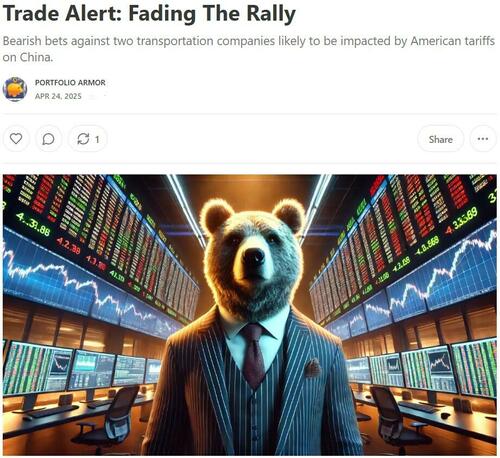The Pointy Tip Of Industrial Warfare

Why Tariffs On China Are Necessary
For those unfamiliar with the term, CNC stands for Computer Numerical Control.
It refers to a method used in manufacturing where pre-programmed computer software controls the movement of factory tools and machinery. This process is commonly used for controlling machines like lathes, mills, routers, and grinders, allowing for precise and automated machining of materials like metal, plastic, wood, or composites.
So instead of manually operating the machine, a CNC system uses code (often G-code) to execute highly accurate cuts, drills, or shapes—making it ideal for mass production and complex designs.
An interaction on X this week shed some light on the economics of this in the context of imports from China. One user bragged about the low price he got on parts he ordered from a CNC machine shop in China, and another lamented that this was bad news for American CNC shops.
This is painful to watch for 🇺🇸 machine shops.
— Const 🇺🇸🏭 (@c0nst) April 23, 2025
China on-demand CNC manufacturer:
- instant quoting
- unbeatable low price
- fast shipping
- quick response time
- quality https://t.co/2pIvGmutG1
In response, the operator of an American CNC machine shop manufactured the part himself, and explained the economics of it--and how the Chinese price quotes only make sense if the Chinese government is massively subsidizing its machine shops (in order to deindustrialize other countries, after which it can have monopoly pricing).
Before we get to it, a brief market comment.
"Speeding Into A Brick Wall"
American businessman and longtime China hand Molson Hart used that analogy to describe what's about to hit the U.S. economy due to the stoppage in trade from China so far.
The White House has put itself and the country in a bad situation but doesn’t realize it yet.
— molson 🧠⚙️ (@Molson_Hart) April 24, 2025
Around April 10th China to USA trade shut down.
It takes ~30 days for containers to go from China to LA.
45 to Houston by sea, 45 to Chicago by train.
55 to New York by sea.
That… pic.twitter.com/8vnGDMWCpt
His point was that we haven't felt the impact of the trade shutdown yet due to shipping lags, and when they hit, it's going to be a COVID-level shock.
As we type this, futures are green. If this ends up being another up day, consider taking the opportunity to hedge. If you're not sure exactly what to do, you can simply divide the dollar amount of your portfolio by the current price of SPY, round it up to the nearest hundred, and then enter that in the Portfolio Armor iPhone app along with your risk tolerance, to find the optimal put options to give you the protection you need at the lowest possible cost.
As a reminder, you can download the Portfolio Armor optimal hedging app by aiming your iPhone camera at the QR code below (or by tapping here, if you're reading this on your phone). Our app can help you find the least expensive hedges given your risk tolerance and time frame.
And if you're a more aggressive investor, you can consider betting against domestic freight companies that are going to be hit by the falloff in Chinese imports. We did just that yesterday.
If you'd like a heads up when we place our next trade, feel free to sign up to our trading Substack/occasional email list below.
Friday Afternoon Update
Took advantage of the rally to bet against Nvidia (NVDA) again.
— Portfolio Armor (@PortfolioArmor) April 25, 2025
Now on to the response by the American machine shop operator.
The Pointy Tip Of Industrial Warfare
I've said it before, I'll say it again... This is what the pointy tip of industrial warfare looks like.
For grins, I CADed up this part. Simple, 2 op, aluminum, can probably make it with tools already in the machine because this is the sort of work I do all day, so I am pretty optimized for small aluminum parts.
Getting these 4 out the door would - if I hustled like a dog - take me about 1 hour. Even at a bankruptcy inducing shop rate of $60 (which no shop in the US is doing work like this for), I still get a price that is 15x the China Price. And I guarantee you, I am as technically skilled at work like this as any shop in China, using the most advanced tools/techniques available.
China is not doing this work for this cheap. Even if you give the most optimistic estimates of their labor costs, facility costs, machine costs, material costs... The price they are making these for has noting to do with any reality. We are not "competing" with China in the traditional Western free-market, may the best man win, commercial competition. You are not out-hustling what China is doing here, there is no AI that will get these parts machined at these prices. No amount of re-industrialization or trade school growth or 0% financing will fix this short of basically doing what China has done which is nationalize the industry throw a thin veneer of "private business" on top of what is basically a government effort to damage trade partners.
Our big mistake is that we've allowed China to trade dump on us and absolutely decimate American industry to the point where it is feeble joke. You are 100% right that American machine shops can't compete and wont't answer the phone for stuff like this - that is what 30 years of unrestricted weaponized trade does to the industry on the receiving end.
We need to de-weaponize China. We will never compete with their costs and they will always be the cheapest - but if we can compete with them on an actual level playing field, we'll bring the price ratio from say 15:1 to 4:1. The China price is $5/part, we're at $20. Ok, now American shops can get to a place where we can be adding value to that part where paying more makes sense - faster turn, no international shipping, no IP concerns, quality DFM feedback to help the customer out, start setting up more R&D oriented relationships, etc etc.
You level the playing field, and America's entrepreneurial spirit can ignite the embers of manufacturing skill that still exist here and catch massive fire.




